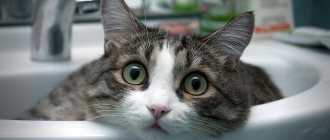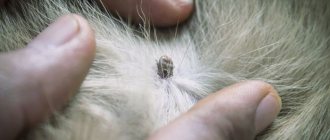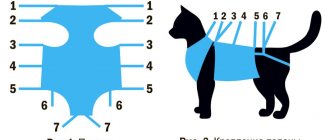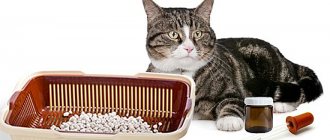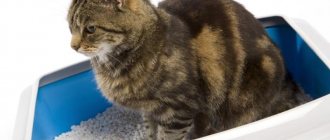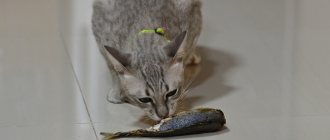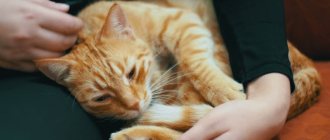The danger of infecting cats with lice
Do cats have lice? Yes, and not only them. When lice appear in cats, the animal's peace and sleep are disrupted. Itching begins, the animal itches and bites itself. In addition to lice, there are also lice eaters. To protect the animal from them, there are various means for external and internal use.
Consequences of a parasite attack for an animal:
- partial or complete baldness;
- development of skin diseases (louse can carry the disease);
- infection with worms followed by depletion of the animal.
The cat is itching
Symptoms and routes of infection by lice eaters
Any cat can become infected, even if it does not go outside - people can bring parasite eggs into the house on their shoes, for example. It is also possible for a groomer to become infected through untreated cat grooming tools. But the greatest risk is for pets who walk outside or interact with other animals, some of whom may have trichodecosis. There is also a transmission of lice from mother to child.
Cat lice are not easy to notice because they hide in the fur, and the symptoms of infestation are also typical for other skin lesions:
- severe itching;
- wounds, scratches as a result of scratching;
- nervous and irritable state of the cat due to unpleasant sensations;
- hair loss, bald patches.
The parasites were called lice-eaters precisely because of the baldness of the sick animal, although in fact cat lice do not feed on hair.
Trichodecosis is not easy to detect if the animal is simultaneously infested with fleas, since the symptoms of these conditions are similar. In any case, when a pet itches or tries to bite something in its fur, it should be carefully examined, even if it seems that the cause of the itching is clear. Upon inspection you will notice:
- small black dots - excrement of lice eaters;
- whitish eggs of the parasite attached to the fur;
- adults.
Lice eaters are not microscopic insects; they can be seen with the naked eye
To make sure there are lice eaters, you can also place the cat under a lamp or sunlight. When the fur heats up, heat-loving parasites will rise to the ends of the hair.
Video: skin diseases in cats - advice from a veterinarian
Ways of transmission of lice
Is it possible to get worms from a cat?
How are parasites transmitted?
- when communicating with another infected animal on the street, in the entrance and in any other place;
- during the grooming procedure, in a veterinary clinic from other animals and instruments that are not disinfected;
- if the owner, shortly before contact with his pet, had contact with a sick animal.
Reference! Human lice and lice in animals are different; an animal cannot become infected with lice that bite a person. Cat lice can be transmitted to humans without the risk of being bitten. But it may not become a carrier for long.
Can cat parasites be transmitted to humans?
Probably, almost every owner of an infected pet is interested in this kind of question - can lice pass from a person to a cat. These parasitic insects are specific, that is, their invasion of humans is not possible. A pet can be a carrier of lice, but an infected animal is only dangerous to members of its own species.
Symptoms
At what age can kittens be treated for fleas?
The first sign is that the pet often itches and looks painful. The fur begins to gradually fall out. Pets' skin deteriorates: cracks, redness, and irritation appear. Brown-black clumps are visible on the fur (these are parasite excrement). By combing, stroking and carefully examining the parasites, you can see with your own eyes as they move.
What do lice and lice look like?
Lice eaters have 3 pairs of paws and a large head. They live and parasitize animals. The most important difference from lice and fleas is their color from gray to yellow. One female can easily lay up to 70 eggs at a time. Consequently, they reproduce very quickly. Lice in cats and dogs are similar in appearance to lice-eaters, but have a long, elongated body without a hard protective shell. They do not feed on the skin, but pierce it and suck out the blood.
What do lice and lice look like?
Fleas are very easy to identify by their appearance: they are large, brown in color and can move by jumping. Lice on a cat or kitten are also sometimes called lice. Nits in cats can be found on the skin and at the base of the hair.
Prevention
After treating a cat for lice, it is important to resort to preventive measures that will somewhat reduce the likelihood of the animal becoming infected in the future. This requires the use of anti-parasitic collars, which are important to change as needed.
The state of health of the skin is important. Healthy, clean skin, free from scratches and wounds, prevents the rapid proliferation of parasites. To keep your pet healthy, you need to feed it a balanced diet, avoid contact with infected pets, and conduct periodic coat checks.
The main sign that indicates a lice infestation is the appearance of whitish nits and dark spots on the skin and fur, which are products of the vital activity of parasites.
Even if their number is insignificant, it is necessary to immediately take measures aimed at destroying lice.
Laboratory diagnostic methods
Tricolor cat: are there males?
To detect parasites and get rid of them, you need to examine your pets yourself. As a rule, there are no laboratory methods for this. True, if the animal owner cannot detect them on his own, he can seek help from a veterinarian. If the doctor cannot find parasites, but there are problems on the skin, the animal is sent for analysis and study of the affected areas of the skin using magnifying laboratory machines.
How to remove lice from a cat
Methods can be divided into several groups. All of them are available for home use. Some ways to remove lice:
- special shampoos against lice, lice and fleas. You just need to wash the animal, making sure that shampoo does not get into the eyes, nose and mouth;
- aerosols for spraying wool. To do this, you need to part the fur to create a parting and spray the product, avoiding the muzzle;
- tablets and drops for internal use. It is best to consult a veterinarian for this. It is quite difficult to force an animal to swallow a pill.
Which drugs to choose
The market for veterinary drugs is saturated with drugs against cat lice. You can choose based on price, manufacturer, shape, composition. Products based on cypermethrin and permethrin are effective. You can buy, for example, Ectometrin from Medilis. Ectometrin is an insectoacaricidal (antiparasitic) agent intended to combat lice, fleas, lice eaters, lice beetles, skin beetles, flies, sarcoptic, ixodid, and chicken mites parasitic on animals (dogs, cats, fur-bearing animals, cattle, pigs, horses, goats , sheep) and poultry (chickens, geese, ducks), as well as for disinsection and decontamination of livestock buildings. The main thing when choosing and using any product is to strictly adhere to the instructions. And on the website you can always use the Ectometrin “working solution” calculator.
How to choose a flea and lice medicine for a cat
If the animal has a small affected area, the medicine should be chosen that will be more convenient for the owner to use.
Reference ! When choosing a shampoo, you should remember that one wash will not be enough. And if an aerosol was chosen, then using a special paper or plastic protection on the neck it is necessary to protect the animal from licking. Ingestion of aerosol may cause poisoning or irritation.
Flea remedies
Drops and sprays
The drops are applied directly to the skin, since insects live precisely at the roots of the hair. Most of the drops should be distributed at the base of the tail, on the back of the head and behind the ears. This is where parasites live and lay eggs. Sprays should not be distributed too close to the skin, as this can injure the kitten.
Collars and shampoos
Collars are a modern and virtually painless method. You just need to put the collar on the sick cat and do not take it off. Gradually, the parasites should disappear, and the animal will get used to the collar. In the first days, a rather specific smell will emanate from the collar, but both the owner and the animal will get used to both the smell and the collar.
How to distinguish lice bites on cats
It is important to correctly identify the parasite on your pet in order to begin treatment properly. Lice, unlike fleas, feed on particles of the animal's epithelium and leave peculiar wounds. Subsequently, the cat begins to develop dermatitis. The animal intensively scratches the affected areas and sometimes even tears out its fur due to the unbearable itching.
We suggest you read: Protection against ticks in the forest
Fleas leave single bites and jump onto the cat to drink blood. Such parasites prefer to damage mainly open areas of the epithelium and do not hide in the fur for a long time. If you don’t know what lice or flea bites look like, then you should pay attention to the following recommendations for distinguishing between types of parasites:
- Fleas are larger, as lice rarely reach a maximum size of 5 mm;
- Lice will not jump and move around the cat at a speed of no more than 15 cm per minute;
- Cat lice will not bite humans;
- The color of the jumping insect's shell is much darker.
Another interesting fact that cannot be noticed without a microscope is that lice do not have eyes, while fleas have a pair of primitively developed eyeballs. Differences also exist at the egg laying stage. Most often, the infection of an animal is noticed only by the large number of nits on the fur.
Folk remedies for ridding cats of lice
Traditional medicine also helps rid furry animals of biting parasites.
Sagebrush. You need to take 40 g of fresh or 20 g of pre-dried leaves and fill them with hot water. Apply the resulting decoction to the animal. It is better to repeat the procedure 3 times, every other day.
Garlic. You need to chop at least 6 cloves of garlic and add hot water. Stir until smooth and leave overnight. The next day, apply the decoction to those places where the cat cannot reach.
Salt. Bring a kilogram of salt to a boil in the amount of water that will cover the salt. Next, pour in 10 liters of water. Make sure that the resulting mixture is at about room temperature so that the kitten feels comfortable swimming in this water.
Treatment options
You can rid your animal of insects using insecticides or traditional methods. The first ones have a quick effect, but some of them negatively affect the cat’s condition.
Shampoos
Insecticidal detergents contain ingredients that repel or paralyze parasites. Active substances can be natural or artificial (permethrin and its derivatives). The ratio of active and auxiliary components determines the effectiveness of the product. To bathe the animal, use a basin that is filled with water. The cat's fur is wetted and then lathered with shampoo. After 10 minutes, the foam is washed off. A single use of shampoo is sufficient to eliminate insects. The following remedies are considered the most effective:
- Ms Kiss. Swiss shampoo based on permethrin rids the cat of parasites in 1 application. The bottle is equipped with a dispenser that allows you to squeeze out the required amount of liquid. Contains conditioner to prevent skin irritation. The shampoo is suitable for bathing kittens older than 4 months.
- BioVax. The drug contains herbal ingredients. A small amount of shampoo is added to the water and the foam is whipped up. The cat is soaped so that the solution accumulates in the hair and at its base. The product can be used to eliminate skin parasites in pregnant or lactating cats.
- Rolf Club. With this product you can remove insects in 1 application. Russian shampoo contains caring components. For 5 kg of cat weight, 5-7 ml of the drug is required.
- Celandine. Contains synthetic antiparasitic substances and plant extracts. The product is contraindicated in kittens under 8 months, malnourished or pregnant cats.
- BIO-GROOM. Head lice shampoo contains permethrin, which eliminates parasites living in the animal's fur in one application. Mix 1 part shampoo with 4 parts water and apply to the cat’s body. After 5-7 minutes, the foam is washed off.
Collars
The collar is a safe and convenient lice repellent designed to rid cats of external parasites at home. The principle of action is no different from that of shampoos. The accessory is impregnated with an insecticidal agent. The collar is not dangerous for cats, it has the following advantages:
- low cost;
- long duration of action;
- no need to bathe your pet.
Disadvantages include a strong odor and the possibility of hair loss where the accessory comes into contact with the skin. It is recommended to wear a collar only when visiting the street or detecting parasites. When choosing a product, consider the following points:
- The circumference of the animal's neck. The accessory must fit tightly, otherwise the cat will quickly remove it.
- Purpose of the product. Collars intended for dogs should not be used on cats. There are remedies indicated for kittens or pregnant cats.
- Best before date. An expired collar will not repel parasites.
- Lack of phosphates. The substances cause allergic reactions. Both cats and people treating animals can be harmed.
Drops
The following products, available in the form of drops, help eliminate lice from a cat:
- Hartz Ultraguard. The American product contains methoprene. Several types of drops are available, suitable for animals of different ages. Insects disappear within 24 hours after application. The medicine does not dissolve in water, so after treatment the cat can walk at any time of the year.
- Celandine. Drops contain fipronil and permethrin. They can be used to treat kittens older than 2 months. Mature lice and larvae are sensitive to the product. The effect lasts 2-3 weeks.
- Bars and Frontline. The preparations contain low-toxic fipronil. Lice are sensitive to the strong odor of the product. Drops can be used to treat kittens older than 3 months.
Before treatment, it is not recommended to bathe the animal for 2-3 days. After applying the drops, the cat's fur should not be exposed to ultraviolet rays. The product is used as follows:
- Part the hair in the neck area and apply drops to the skin. To increase effectiveness, the product is rubbed in. Do not apply the drug to the lower back. An animal may lick the solution and become poisoned.
- During the procedure, avoid getting the drug into the cat’s eyes and nose. After treatment, the wool should not be combed.
Sprays
This form is intended for spraying the active substance onto the skin and hair of the pet. The procedure is carried out as follows:
- 3 days before the start of treatment, the cat stops bathing. Using a collar will prevent the medication from being licked off.
- By spreading the fur, the skin is treated. It is recommended to carry out the procedure outdoors or in a well-ventilated area. The bottle is placed at a distance of 30-40 cm from the cat’s body. When processing the head, the animal's eyes and muzzle are covered.
- After the composition has dried, the cat is combed. It is not recommended to bathe the animal or let it go outside for 2 days. Repeated treatment is carried out after 2-3 weeks.
The following medications are considered the most effective:
Bayer Bolfo spray against parasites.
- Bayer Bolfo spray. An aerosol containing propoxur does not cause poisoning or allergic reactions. Can be used to treat trays, toys and bedding areas. 2 ml of aerosol is enough to spray on 1 m² of surface. The product is contraindicated for pregnant and lactating cats.
- Palladium. Can be used to treat kittens older than 6 weeks. To treat an animal weighing 4 kg, 5-6 sprays are sufficient.
- Sentry. Contains natural essential oils. The composition emits a strong odor that repels parasites. To rid a cat of parasites, 8-10 presses are enough. Repeated treatment is performed after 2 weeks. To maintain the effect, treatment is carried out for a year.
- Blochnet Hartz Frontline. A product containing fipronil is effective against fleas and lice. The effect lasts for 3 months. The recommended single dose is 3-6 ml of the drug. The spray is used to treat kittens from 1 week.
The use of folk remedies
To eliminate cat lice at home, use the following folk recipes:
- Sagebrush. Lice are sensitive to the smell of the plant. 20 g of dry leaves are poured into 0.5 liters of water and boiled for 20 minutes. The cooled broth is applied to the cat's body. After treatment, the lice begin to leave the animal's fur and skin.
- Garlic. Many external parasites, including fleas and lice, are sensitive to this vegetable. 6 crushed cloves are poured into 600 ml of boiling water. The product is infused for 12 hours and applied to the animal’s body. You should avoid licking the infusion, which can cause digestive disorders.
- Salt. This method of treatment is not used in the presence of wounds and rashes. 1 kg of salt is mixed with a small amount of water. The solution is brought to a boil and poured into a basin with 10 liters of water. The cat is kept in the bath for 5 minutes, ensuring the absorption of the composition. Without washing off the solution, the animal is combed.
How to bathe a cat
Cats are known to wash themselves. But in their environment, various bacteria can grow and settle on the wool. If they enter the stomach, they can cause illness and even infection. Therefore, you need to periodically wash the cat yourself using a special shampoo. You need to choose a shampoo that matches your coat type.
Bathing a cat
Reference! There are even tinted shampoos for cats that help even out the tone of the coat and make it several shades darker or lighter.
You need to roll cotton wool into balls and plug your pet’s ears, as they are a particularly sensitive area. It is better to prepare a container and place a terry towel on its bottom. If the animal lifts the towel during the washing process, it can be removed, but it is worth keeping in mind that the animal can scratch the bottom of the container with its claws.
What do cat lice look like?
If you want to recognize cat lice, you need to know what they look like. Outwardly, these are rather small parasites, their body is elongated, but quite dense. On the triangular head there is a special recess for capturing hair. Lice are easy to distinguish by their light yellow color and sedentary lifestyle - they will never jump, like fleas.
A distinctive feature of lice eaters is their powerful jaws, which allows them to easily grab and bite off pieces of skin and fur. This is what causes severe itching in pets.
Caring for your pet during treatment
During the treatment period, it is necessary to ensure that medications for external use do not enter the animal’s mouth. It is also necessary to limit the animal’s contact with other patients and stop letting it go outside alone. Periodically, the fur and skin should be examined to ensure that they are getting rid of parasites. And if there are no fewer of them, then you urgently need to contact a veterinarian and change the method of treatment.
Reference ! You definitely need to pay attention to behavior. The more the animal itches, the more difficult it will be to treat.
Why are they dangerous?
Lice on cats are a source of discomfort and irritation, physical inconvenience, accompanied by intense itching. The result is wounds and abrasions on the cat’s skin. Severe infection provokes excessive hair loss and baldness; it is quite difficult to stop this process. The main consequence of parasitism by cat lice is dermatitis of various types, as well as pediculosis.
